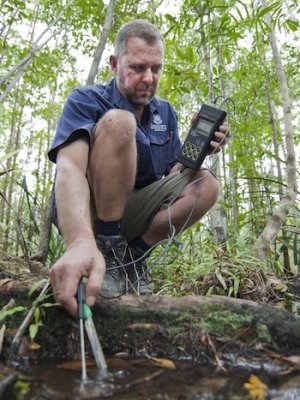
Scientists have been startled to discover unique ecosystems of fauna and flora thriving around highly acidic springs in far north Queensland.
The springs have pH levels approaching those of the devastating acid rain that falls in industrialised areas of the northern hemisphere, say the researchers from The University of Queensland (UQ).
A team headed by Professor Craig Franklin discovered the naturally occurring acidic springs "which are believed to be unique in the world" along tributaries of the pristine Wenlock River, on the Steve Irwin Wildlife Reserve.
"The springs sit at the base of a bauxite plateau and it is fascinating to us as scientists that they pump out water that has a very low pH, is highly acidic, yet they are teeming with life," Professor Franklin said.
"It is very clear that the flora and fauna are related to that acidity, to that unique water composition."
The researchers have documented unique flora and fauna assemblages and described "essentially a new type of rainforest", or as it is known scientifically, a groundwater-dependent ecosystem.
Professor Franklin said the region was largely uncharted scientifically, and much research was needed to even start to explain how the flora and fauna could co-exist so successfully with the acidic water.
In north America, acid rain that is the result of industrial pollution has made some lakes so acidic they can no longer support native fish species.
In both America and Europe, acid rain has had negative effects on human health, damaged forests and soils, and killed insect and aquatic life forms.
"Life thriving amid this level of acidity is a new discovery to mankind and will be the focus of much research over coming years," Professor Franklin said.
Professor Franklin said the findings could provide important clues for industrialised countries in the northern hemisphere seeking ways of coping with acid rain.
"It is fascinating that water with similarly low pH levels in the northern hemisphere has caused the loss of huge numbers of fish and aquatic organisms, yet here we have almost equivalent pH levels and life is abundant and the organisms have evolved to cope with those acidic conditions," he said.
"In fact, their survival may be dependent upon the acidic conditions."
Professor Franklin, who is an expert in conservation physiology, said the UQ research teams had noticed that many of crocodiles on the Wenlock River had very "stained and weak-looking" teeth. It had now become apparent that this was possibly related to the acidic spring water.
He said a UQ PhD student would soon begin a three-year investigation into the life of the aquatic animals living around the acidic springs, and how the fish and amphibians in particular were able to cope with the acidic conditions.
"We currently know very little about this natural phenomenon and it deserves our attention and conservation," Professor Franklin said.
"Detailed and comprehensive further investigation is needed. We have only just scratched the surface in terms of making discoveries in terms of these unique springs and rainforest."
UQ researchers have been working in north Queensland for the past seven years on what is now the 1350sq km Steve Irwin Wildlife Reserve, 80km north of Weipa. The Australian Research Council and Australia Zoo funds their work.
The discovery of the acidic springs and their thriving wildlife is reported for the first time this week in UQ's Graduate Contact magazine, which is sent to the university's 140,000-strong alumni group.
Media: Professor Craig Franklin, ph +61 7 3365 2355; or UQ Communications: Fiona Cameron ph + 61 7 3346 7086; Kathy Grube ph +61 7 3346 0561.
NB video footage is available of Professor Franklin's team at work in the Wenlock River region. It can be viewed here
.jpg)









